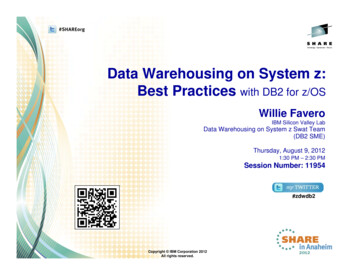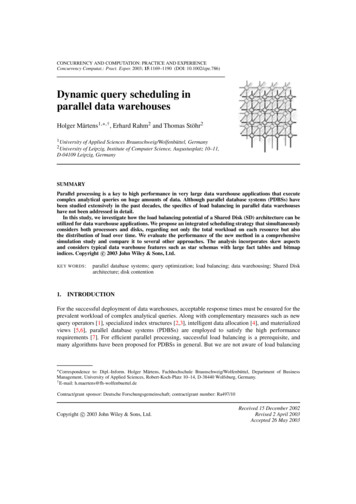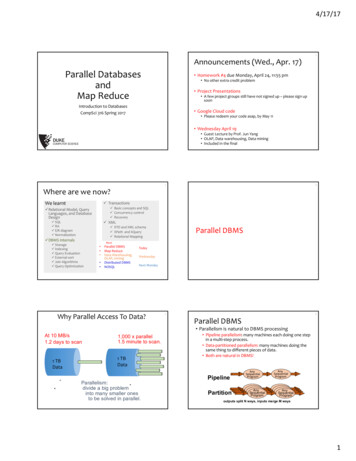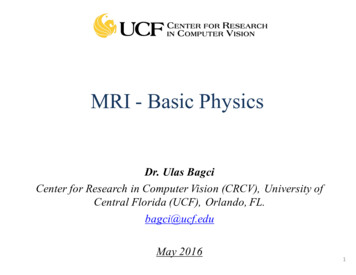
Transcription
DATA-PARALLEL RASTERIZATION OF MICROPOLYGONSAN HONORS THESISSUBMITTED TO THE DEPARTMENT OF COMPUTER SCIENCEOF STANFORD UNIVERSITYEdward LuongPrincipal Adviser: Patrick HanrahanJanuary 2010
AbstractWe present two data-parallel algorithms for rasterizing micropolygons. Our approaches differ from current techniques by parallelizing across polygons. Thefirst, L OCKSTEP, processes micropolygons in lockstep and runs with high utilization (65%) for a small number of SIMD units, despite variance in the amountof rasterization work for each micropolygon. The second, R EPACK, compactsworks and is able to maintain high utilization (85%) even for large number ofSIMD units. While R EPACK operates with high utilization, it incurs overhead fromrepacking data. We study the performance and utilization of our algorithms onsimulated hardware with varying amounts of SIMD units. We make predictionsabout the overall cost of rasterizing micropolygons in a future real-time system.ii
AcknowledgementsThis thesis represents a year of research in Pat Hanrahan’s graphics group. Patencouraged me to try my hand at research after I took his course on Image Synthesis. We quickly found a project that interested me, and since then, he hasalways been enthusiastic about my involvement with the project and extremelysupportive of my work.I was fortunate to have been able to inhabit Gates 381 all year. I am extremelylucky to have worked closely with Kayvon Fatahalian. Kayvon was instrumentalin getting me up to speed with the research project. He was always available forquestions and was rarely short on answers. His insight and guidance has beencritical to the success of my research. In addition to Kayvon, I was lucky to haveas officemates, Solomon Boulos and Matt Fisher. Solomon and Matt have bothshared with me their deep knowledge of computer science, math, work, graduateschool, and life in general. I am also glad to have worked with Kurt Akeley andBill Mark. Their involvement in our research meetings have been invaluable.I’d like to thank Mary McDevitt for all the feedback on all of my drafts. Shewas very flexible and worked around my extremely tight schedule.Thanks to all my colleagues in the honors program, especially Lawson Wongand Sergey Levine. Also, I’d like to thank all my wonderful friends here at Stanfordwho have been so understanding of my busy schedule. In addition, thanks to allof my friends in the CS198 section leading program, where I learned so muchabout the value of clear communication.I’d like to thank my parents, William Luong and Hue Luong. I would not bewhere I am without their encouragement and support. They have always stressediii
the important of balance between life and work, which usually amounted to themreminding me to take more breaks. Also, my brother, Edison Luong, has been acontinual inspiration in my life.Finally, I’d like to thank Tiffany Nguyen for her understanding and loving support.iv
ContentsAbstractiiAcknowledgementsiii1 Introduction12 Background42.1 REYES . . . . . . . . . . . . . . . . . . . . . . . . . . . . . . . . . . . .42.2 Parallelism . . . . . . . . . . . . . . . . . . . . . . . . . . . . . . . . .52.3 Point Sampling. . . . . . . . . . . . . . . . . . . . . . . . . . . . . .52.4 Traditional Visibility Algorithms . . . . . . . . . . . . . . . . . . . . .62.4.1Tiling methods . . . . . . . . . . . . . . . . . . . . . . . . . .72.4.2Hierarchical methods . . . . . . . . . . . . . . . . . . . . . . .83 Implementation113.1 Algorithm . . . . . . . . . . . . . . . . . . . . . . . . . . . . . . . . . . 113.2 Parallelization . . . . . . . . . . . . . . . . . . . . . . . . . . . . . . . 143.2.1L OCKSTEP . . . . . . . . . . . . . . . . . . . . . . . . . . . . . 143.2.2R EPACK . . . . . . . . . . . . . . . . . . . . . . . . . . . . . . . 164 Results194.1 Comparison of Implementations . . . . . . . . . . . . . . . . . . . . 204.1.1L OCKSTEP . . . . . . . . . . . . . . . . . . . . . . . . . . . . . 204.1.2R EPACK . . . . . . . . . . . . . . . . . . . . . . . . . . . . . . . 22v
4.2 Support for Rasterizing Quads . . . . . . . . . . . . . . . . . . . . . . 244.3 Discussion . . . . . . . . . . . . . . . . . . . . . . . . . . . . . . . . . 265 Conclusion285.1 Contributions . . . . . . . . . . . . . . . . . . . . . . . . . . . . . . . 285.2 Future Work . . . . . . . . . . . . . . . . . . . . . . . . . . . . . . . . 29References30vi
List of Tables4.1 Breakdown of utilization per stage and fraction of time spent ineach stage (in parenthesis) for the L OCKSTEP. Overall utilizationfalls off quickly for larger vector widths. The decrease in total operations per micropolygon shows benefit of parallelism. Setup isomitted because it constitutes less than 0.01 of the runtime. . . . . 214.2 Breakdown of utilization per stage and fraction of time spent ineach stage (in parenthesis) for the R EPACK. We break out the streamloading step, Test Stream-load. . . . . . . . . . . . . . . . . . . . . . . 224.3 Overhead for each stage of the pipeline. Note that all instructionsin Test Stream-load are considered overhead. . . . . . . . . . . . . . 224.4 Breakdown of utilization per stage and fraction of time spent ineach stage (in parenthesis) for the L OCKSTEP when using quads instead of triangles. . . . . . . . . . . . . . . . . . . . . . . . . . . . . . 244.5 Breakdown of utilization per stage and fraction of time spent ineach stage (in parenthesis) for the R EPACK when using quads instead of triangles. . . . . . . . . . . . . . . . . . . . . . . . . . . . . . 244.6 Difference in operations per micropolygon when using trianglesversus quads. . . . . . . . . . . . . . . . . . . . . . . . . . . . . . . . . 26vii
List of Figures1.1 Complex surfaces such as this frog’s skin are represented accuratelyusing micropolygons. . . . . . . . . . . . . . . . . . . . . . . . . . . .22.1 Rasterization of a polygon and a micropolygon using 2 2 tiles. APointInPolygon test was performed for the sample in each coloredbox. Blue boxes yield hits and yellow boxes yield misses. . . . . . . .82.2 Traversal of the tile hierarchy for a polygon. Green tiles are determined to be completely inside a polygon and pink tiles are determined to be completely outside a polygon. Samples that lie withinwhite tiles still need to be tested. . . . . . . . . . . . . . . . . . . . .93.1 Pseudocode for RAST MP. . . . . . . . . . . . . . . . . . . . . . . . . . 123.2 Differences in bounding boxes for quads versus two triangles. Lightblue regions are tested once whereas dark blue regions are testedtwice. . . . . . . . . . . . . . . . . . . . . . . . . . . . . . . . . . . . . 123.3 Pseudocode for L OCKSTEP (RAST MP). . . . . . . . . . . . . . . . . . . 143.4 Diagram of R EPACK. The stages are separated by buffers. Test (conditionally) stream loads its input and compacts its output. Buffersare twice as wide as the vector width. . . . . . . . . . . . . . . . . . . 164.1 Our test scenes are select frames from animation sequences, fromleft to right: B ALL ROLL, C OLUMN P IVOT, T IGER J UMP, and TALKING.viii20
4.2 Comparison of total operations between triangles and quads fordifferent scenes. For each scene, the column on the left is for triangles and the right column is for quads. The quad column is scaledrelative to the triangle column. Note that the amount of work inProcess is roughly equal. Time spent in Bound is halved since thereare half as many micropolygons. . . . . . . . . . . . . . . . . . . . . 25ix
Chapter 1IntroductionImage synthesis is the process of transforming a scene, typically represented asmathematical models in 3D space (R3 ), into a flat, discrete representation (theimage plane). Nearly all graphics systems break this process into three stages: geometry, shading, and rasterization. The geometry stage is usually the first stageand is responsible for processing incoming geometry for the rest of the pipeline.It includes per-polygon computations (such as tesselation) and per-vertex computations (such as displacement). The shading stage determines the color valueson the surface. The color of the surface is usually computed using a combination of surface parameters, textures, and light sources. Finally, rasterization isthe stage that discretizes scene data into an image. Broadly speaking, rasterization is the process of determining the color contribution of each polygon to thepixels in an image.While rasterization is responsible for correctly interpolating color information, the main challenge in rasterization is determining visibility. Determiningvisibility consists of identifying the regions of surfaces in a scene that are visible from a virtual camera. Most visibility algorithms optimize for large polygons(many pixels in size). Many efficient algorithms exist, and nearly all modernGPUs have been able to exploit data-parallelism to attain high throughput forrasterization.1
CHAPTER 1. INTRODUCTION2Figure 1.1: Complex surfaces such as this frog’s skin are represented accuratelyusing micropolygons.There is increasing demand for rendering realistic images in real-time graphics systems, and in order to synthesize realistic images, we often need to handle complex geometry. Techniques for approximating complex geometry usinga combination of coarse geometry and shading have been employed in currentgraphics systems. However, smooth surfaces with high curvature, or highly detailed surfaces–such as bumpy or displaced surfaces–cannot be faithfully reproduced with these techniques. As the bar for image quality rises, approximationsthat fall short of actual detailed geometry will no longer be suitable.A simple way to capture high geometric detail is to tesselate geometry intomicropolygons, polygons with less than a pixel area. Such a strategy is popularamong offline renderers (Apodaca & Gritz, 2000; Hou, 2009); however, currentreal-time graphics systems are not equipped to handle micropolygon workloads.Several changes to the graphics pipeline are needed for a complete transitionfrom large polygons to micropolygons. A study undertaken at Stanford Universityaims to design a micropolygon pipeline for future GPUs. Work that addresseschanges to the tesselator appear in (Ano, 2009b).The work discussed here focuses on rasterization. An efficient, high-throughputrasterizer is a critical component of a micropolygon rendering pipeline. Currentrasterization algorithms are extremely inefficient for micropolygons due to theinability to quickly determine visibility when polygons become subpixel in size.
CHAPTER 1. INTRODUCTION3This thesis discusses data-parallel formulations of an algorithms for rasterizingmicropolygons. It presents a detailed workload analysis of our implementaionsand characterizes the micropolygon rasterization workload to guide future optimized hardware and software implementations.Parts of this thesis appear in (Ano, 2009a).OutlineThe next chapter provides the necessary background for the rest of the thesis.Chapter 3 presents our algorithm and data-parallel implementations. Chapter 4provides performance results for a simulation of implementations. The last chapter summarizes the work and presents plans for future work.
Chapter 2Background2.1REYESThe REYES rendering architecture is an architecture developed at Lucasfilm forquickly rendering high-quality images (Cook et al., 1987). REYES was specificallydesigned to handle models with a large number of polygons. Models are inputas high level primitives which are are split into sub-primitives (Split). This process repeats until each sub-primitive is determined to be small enough. The subprimitives are then uniformly tesselated into pixel-sized micropolygons (Dice).Micropolygons are shaded (Shade) and then rasterized (Visibility). Since only asmall set of fully-tesselated geometry ever needs to be in memory, the REYESarchitecture is extremely well-suited for scenes with high geometric complexity. The REYES architecture motivates the use of micropolygons to render highquality images of scenes with high-geometric complexity.4
CHAPTER 2. BACKGROUND2.25ParallelismIn this thesis, we only consider data-level parallelism (data parallelism) as opposed to thread-level (multicore) parallelism. The most common form of datalevel parallelism exploits the efficient execution of a single instruction on multiple data (SIMD). We refer to the “multiple data” as a vector, and the vector widthis the amount of data-level parallelism an architecture supports per operation.Thread-level parallelism, on the other hand, addresses parallelism from running separate threads in parallel. Different threads usually perform different tasks,and coordination between threads must occur if there are data dependencies.Thread-level parallelism usually does not scale as well as data-level parallelism.As the number of threads (cores) increases, either algorithms need to change toaccommodate the extra threads or communication between threads becomes aperformance barrier. Note that thread-level parallelism is more general than dataparallelism. That is, multiple threads can be used to exploit data parallelism;however, the overhead needed for general thread-level parallelism is much higherthan what is needed to support SIMD processing (Hennessy & Patterson, 2002).2.3Point SamplingThe frame buffer represents the image plane as a collection of (X, Y ) samples.While the goal of rasterization is to determine the color values for each of thesesamples, fundamentally, rasterization is about computing visibility at each sample. More precisely, given a polygon, P , we determine the set of samples coveredby P . A solution to this problem returns a list of polygon-sample pairs, (P, s),where each pair corresponds to P covering s.The main geometric operation for computing visibility is PointInPolygon. Fora polygon, P , and a sample, s, PointInPolygon tests if s is covered by P . A commonimplementation of PointInPolygon for convex polygons) uses edge functions: s isinside P if all edge functions evaluated at s are all positive.
CHAPTER 2. BACKGROUND6An alternate of computing visibility frames the problem as point sampling visibility for a polygon in 2D (X, Y ) space. This formulation makes extending rasterization to support motion blur and depth of field natural: rasterizing micropolygons under motion blur or camera defocus becomes the problem of point sampling in 3D (X, Y, T ) space or 5D (X, Y, T, U, V ) space, respectively. PointInPolygon generalizes into higher dimensions by using hyperplanes instead of edges.This type of sampling has been implemented (Ano, 2009a); however, it is out ofthe scope of this thesis.A simple frame buffer contains a sample at the center of each pixel in the image; however, most modern systems use multiple samples per pixel for multisampling anti-aliasing (MSAA). MSAA helps remove aliasing artifacts (“jaggies”)by increasing the sampling rate and, consequently, the Nyquist frequency. In addition to increasing the sampling rate, samples can be placed randomly on theframe buffer to improve quality. Randomization helps decrease structured aliasing by replacing it with noise. Jittered sampling is a common sampling patternthat approximates a Poisson disk sampling (Cook, 1986). With jittered sampling,if each pixel contains S samples, we divide the pixel into S uniform regions. Weplace a sample at the center of each subpixel region, then jitter it by some random amount, (4x , 4y ). Jittered sampling provides similar benefits as Poissondisk sampling, and its structure is convenient for most output image formats (i.e.,a grid of pixels).2.4Traditional Visibility AlgorithmsBefore reviewing previous techniques, we describe two metrics used to evaluatethe efficiency of a rasterizer. Sample test efficiency (STE) is the ratio of the number of PointInPolygon hits to the number of PointInPolygon tests. Utilization is ameasure of how efficiently vector processing units are utilized. High utilizationis an indication of good parallelization. Typically, STE is determined by the algorithm, whereas utilization is determined by the actual implementation. However,some algorithms may lend themselves to better parallel implementations than
CHAPTER 2. BACKGROUND7others.Most rasterization techniques can be split into four steps. First, the Setup stepperforms any necessary per-micropolygon setup computations. Second, in theBound step, a set of candidate samples is identified. Third, the Test step computes PointInPolygon for each candidate sample. Last, Process updates the framebuffer for each tested sample that passes PointInPolygon. This thesis focuses onall steps up until Process because computing coverage is the biggest algorithmicchallenge.2.4.1Tiling methodsTiling methods typically tradeoff STE for wide data-parallelism. In its simplestform, a tiling method performs PointInPolygon tests on all samples in the framebuffer in parallel. Pixel-planes accelerated this computation by using speciallydesigned memory units augmented with a tree of one-bit adders (Fuchs et al.,1986). While this approach is massively parallel, much of the computation iswasted. If the average polygon covers A samples and there are R total samples,Athis algorithm has a fixed STE of R, which can be extremely low if used naı̈vely ona large framebuffer.Tiling methods have been refined to improve STE. Rather than testing thewhole frame buffer, tiling methods first divide the frame buffer into tiles (rasterstamps). Polygons are sorted by which tiles they cover, and then the PointInPolygon tests for all samples in each tile are performed in parallel (Fuchs et al., 1989;McCormack & McNamara, 2000). In summary, tiling methods are broken downas follows: Setup computes edge equations for polygon Bound determines tiles covered by polygon. for each covered tile, Test performs PointInPolygon tests in parallel using theprecomputed edge equations.
CHAPTER 2. BACKGROUNDPolygon: STE 73%8Micropolygon: STE 8%Figure 2.1: Rasterization of a polygon and a micropolygon using 2 2 tiles. APointInPolygon test was performed for the sample in each colored box. Blueboxes yield hits and yellow boxes yield misses.Many implementations using tile sizes ranging from 4 4 to 128 128 havebeen proposed (Pineda, 1988; Fuchs et al., 1989; Seiler et al., 2008). For largepolygons, these schemes can attain both high utilization and high STE becauseovertesting only occurs on tiles that straddle the polygon border. However, formicropolygons, nearly every tile tested will contain a micropolygon edge. Figure 2.1 illustrates this effect with a small tile size. Samples within the polygon areshown in blue. Samples tested during rasterization, but not covered by the polygon, are shown in yellow. STE of the micropolygon is low because the area of themicropolygon is small compared to the area subtended by a tile. Consequently,STE becomes lower for larger tiles.2.4.2Hierarchical methodsHierarchical methods are a variant of tiling methods that use a hierarchy of tilesof different sizes (Greene, 1996). Hierarchical methods identify hit samples bytraversing the tile hierarchy and selectively refining tiles that lie on a polygon’sedge (see figure 2.2). First, coverage for polygons against coarse tiles is computed. Each coarse tile that is covered is refined into smaller tiles unless the tile
CHAPTER 2. BACKGROUND9Figure 2.2: Traversal of the tile hierarchy for a polygon. Green tiles are determinedto be completely inside a polygon and pink tiles are determined to be completelyoutside a polygon. Samples that lie within white tiles still need to be tested.is determined to be completely inside a polygon or completely outside a polygon. This process generally ends when the number of samples in a tile equals thevector width of the architecture. This tile hierarchy traversal can be performedin a cache coherent manner using Hilbert curves (McCool et al., 2001). The opensource renderer, Aqsis, builds a kd-tree of samples and traverses this tree to findcovered leaf nodes (Aqs, 2008). In general, hierarchical methods can be summarized as follows: Setup performs per-micropolygon computation for hierarchical traversal. Bound traverses the tile hierarchy. This step identifies tiles of various sizesthat lie completely inside the polygon. It also identifies small tiles on theedge of the polygon. Test performs PointInPolygon tests for tiles on the edge of the polygon.Hierarchical methods can attain high STE for large polygons because they canoften identify large regions samples that yield hits without performing PointInPolygon tests for each sample. It is possible to generate more hits than PointInPolygon tests, attaining STE 100%. Although hierarchical methods may incur large setup costs (tile hierarchy traversal), there is often plenty of parallelismacross samples within coarse tiles that are completely inside a polygon.Unfortunately, with micropolygons, hierarchical methods fail to quickly identify coarse tiles that are completely covered for the same reasons tiling methods
CHAPTER 2. BACKGROUND10have low STE. Micropolygons are almost all edges, or, alternatively stated, theregion inside micropolygons are smaller than the most refined tile size. A hierarchical method will traverse the whole tile hierarchy for each micropolygon, onlyto identify tiles that still lie on a micropolygon’s edge. The expensive cost of setupis not justified since STE will still be low and the amount of parallelism within thepolygon will be limited.
Chapter 3ImplementationIn this chapter, we present an algorithm for computing polygon visibility andtwo data-parallel formulations of our algorithm. To be more precise, the visibility problem for micropolygons is framed as follows: we are given many, smallpolygons (micropolygons) and a structured set of points (frame buffer), and wewish to determine which points are covered by which polygons. We assume thepolygons are either triangles or quads (however, we continue to use the word micropolygon in lieu of microtriangle or microquad).3.1AlgorithmExpensive setup and diminishing returns on parallelism within a polygon makeprevious algorithms inefficient for micropolygons. Moreover, due to the smallsize of miropolygons, the number of micropolygons generated to represent ascene will be much larger than the number of polygons generated to representa scene.We choose an algorithm specifically tailored for micropolygon workloads. Permicropolygon setup is minimized to deal with an effect of Amdahl’s Law (Hennessy & Patterson, 2002): per-micropolygon setup cost is a lower bound on total rasterization cost. In our algorithm, Setup/Bound computes a screen-space11
CHAPTER 3. IMPLEMENTATION12RAST MPCull backfacingBBOX Compute MP bboxfor each sample in BBOXhit test MP against sampleif hitProcess hit// Setup// Bound// Test// ProcessFigure 3.1: Pseudocode for RAST MP.Figure 3.2: Differences in bounding boxes for quads versus two triangles. Lightblue regions are tested once whereas dark blue regions are tested twice.axis-aligned bounding box (AABB) of the polygon. The AABB identifies candidate samples to perform PointInPolygon tests. By using jittered sampling, wecan quickly retrieve these candidate samples by snapping the AABB to subpixelboundaries. While other simple geometric structures, such as oriented boundingboxes, can be used to identify a tighter set of candidate samples, traversing themgenerally requires more work.For each candidate sample, we perform a PointInPolygon test. PointInPolygonis implemented using edge equations. If a sample is covered by the polygon, weprocess the micropolygon-sample pair. For the visibility problem, this amountsto returning the micropolygon-sample pair. For rasterization, this amounts toupdating the frame buffer with the appropriate color value.The use of bounding boxes to determine candidate samples motivates supporting quads in our graphics pipeline. First, a bounding box can fit a quad quitewell, and in the worst case, cannot be any worse than the union of the bounding boxes of two triangles. For example, traversing the candidate samples of two
CHAPTER 3. IMPLEMENTATION13neighboring triangles may cause samples to be tested twice. Figure 3.2 illustratesthis effect. The light blue regions contain samples that are tested only once thatresult in misses. The dark blue regions are samples that are needlessly testedtwice. Second, a pipeline that supports quad may create less work for the wholepipeline. A tesselator can generate roughly half as many quads for a scene thanthe number of triangles generated for the same scene.In most systems, triangles are preferred over quads because triangles are simpler to handle. Triangles are always convex whereas the convexity does not always hold for quads. However, when quads are very small, problems that arisefrom assuming convexity can be tolerated without objectionable artifacts. (Alternatively, without too much complexity, the PointInPolygon test can also bewritten to correctly handle convex quads.) We continue to frame our solutionin terms of triangles; however, our solution is easily extended for quads.In summary, our algorithm can be broken down into four steps (pseudocodeis also provided in figure 3.3): Setup performs per-micropolygon setup computation, including back-faceculling. Bound computes an AABB for the micropolygon. (Note: this is still considered per-micropolygon setup.) Test performs PointInPolygon tests between samples in the AABB and themicropolygon. Process updates the frame buffer using color information from the micropolygon vertices.
CHAPTER 3. IMPLEMENTATION14L OCKSTEP: parallel formulation of (RAST MP)Cull backfacingCompute edge equations [ optional ]BBOXes ComputeBBoxes (M P s)Smax hmax (BBOXes. numSamples )for i 0 to Smaxhits PointInPolys (si , M P s)Process ( hits , M P s)Figure 3.3: Pseudocode for L OCKSTEP (RAST MP).3.2ParallelizationAlthough micropolygons only cover a few samples, the large number of micropolygons provides a rich source of data-parallelism. We implemented two dataparallel formulations of RAST MP that parallelizes across micropolygons. This approach to parallelization is a departure from common rasterizers, which exploitparallelism within micropolygons as opposed to across micropolygons.Our implementations run on a simulated vector machine, which supportsstandard vector instructions for operating on vectors of floats and integers. Wealso require special instructions for manipulating bit masks and support for maskedinstructions. We explain these instructions in more detail when needed. We expect our implementations to translate naturally to a virtualized pipeline with vector instructions or to a hardware implementation with many data-parallel execution units.3.2.1L OCKSTEPThe first implementation, L OCKSTEP, keeps all of the data-parallel executionsof the algorithm in lockstep. For each batch of polygons, Setup optionally precompute edge equations that are used later in Test. The benefits of pre-computatingedge equations depend on the architecture. In addition, Bound (a portion ofSetup) computes AABBs for micropolygons. Test iterates Smax times, where Smax is
CHAPTER 3. IMPLEMENTATION15the maximum number of candidate samples among all bounding boxes. This requires a hmax vector instruction that computes the maximum element of a vector.Each iteration, a PointInPolygon test is performed si where si is the i-th sample inthe AABB. We mask out lanes when the iteration count exceeds the total numberof candidate samples. (Recall that masked out lanes lead to lower utilization.) Ifan iteration of Test yields any hits, Process returns the vector of hits. As a smalloptimization, we can skip Process if all lanes fail.For a rasterizer, Process must update the frame buffer with the correct colorvalues from the micropolygon. To determine the color, we have to store additional shading information for each micropolygon vertex. In our system, micropolygons are already shaded; consequently, the rasterizer only needs to maintainthe color of each vertex. Combining location data (needed for visibility) and color(needed only for rasterization), each micropolygon vertex requires 28 bytes. Fora triangle, this amounts to 84 bytes per micropolygon. A more space-efficientalgorithm can share micropolygon vertex data between micropolygons.Updating the frame buffer in parallel may introduce a data hazard. If two micropolygons hit the same sample (collision), processing cannot proceed in parallel because they will both try to update the frame buffer location. We expect collisions to be rare because of the way a tesselator generates micropolygons. Mosttesselators will tesselate patches of a surface at a time. Collisions can only occurwhen the patch lies on a silhouette edge (which may be created by displacement),or when two patches that overlap in screen-space are tesselated consecutively.One solution for software implementations can provide two execution paths:one for batches of work without collisions proceeds in parallel and another forbatches of work that might have a collision serializes (Owens, 2002). Assumingcollision detection is cheap (a method using hashing is proposed) and collisions(and false positives) are rare, this approach is acceptable. A hardware solutionto this problem also exists (McCormack et al., 1998). It builds batches of noncolliding hits and processes the batch in parallel when filled or when a collisionis about to be introduced. For simplicity, our current implementation serializesall accesses to the frame buffer and performs all other computations in parallel.
CHAPTER 3. IMPLEMENTATION16Figure 3.4: Diagram of R EPACK. The stages are separated by buffers. Test (conditionally) stream loads its input and compacts its output. Buffers are twice as wideas the vector width.3.2.2R EPACKDivergent execution (or divergence) occurs when vector l
2.2 Parallelism In this thesis, we only consider data-level parallelism (data parallelism) as op-posed to thread-level (multicore) parallelism. The most common form of data-level parallelism exploits the efficient execution of a single instruction on multi-ple data (SIMD). We refer to the "multiple data" as a vector, and the vector width





![Introducing PARALLEL: Stata Module for Parallel Computing [draft]](/img/54/parallel.jpg)




